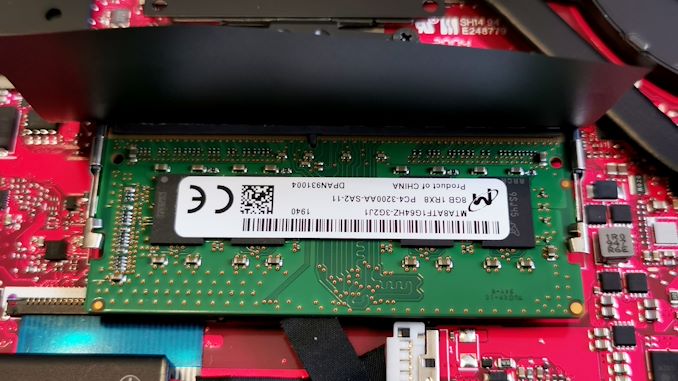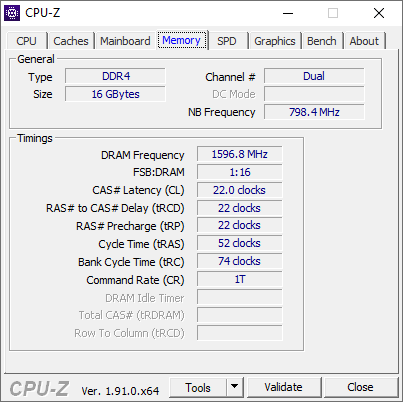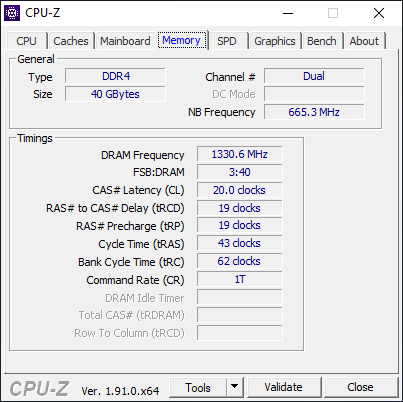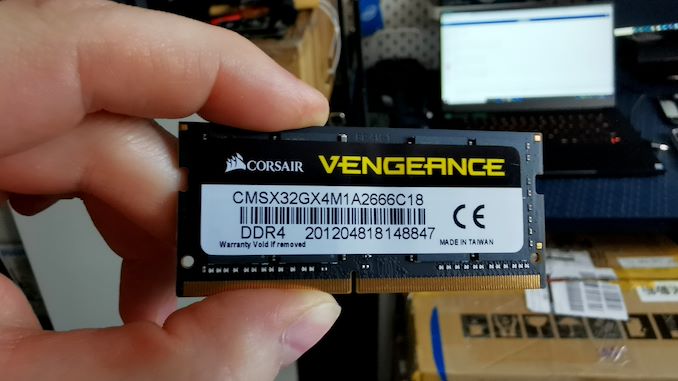AMD’s Mobile Revival: Redefining the Notebook Business with the Ryzen 9 4900HS (A Review)
by Dr. Ian Cutress on April 9, 2020 9:00 AM ESTRyzen 9 4900HS with DDR4-2666 and DDR4-3000
In our ASUS Zephyrus G14, we have a total of 16 GB of DDR4. This is split between a single SO-DIMM module of 8 GB, and a set of 8 GB memory soldered onto the board. AMD will offer a version with 16 / 16, however this might come at a later date.
This memory is running at the AMD recommended for these processors, DDR4-3200. Through our inspection tools, we can tell that this memory is running with subtimings of 22-22-22 with a command rate of 1T. The command rate is certainly good, however the 22-22-22 is a little slower than what we see on a desktop system running at this speed, because here we have a system that conforms to JEDEC’s subtiming requirements.
For our memory testing we wanted to see what speeds and capacities we could achieve. Corsair very kindly sent us some modules of 16 GB DDR4-3000 and a module of 32 GB DDR4-2666. This would give our system either 24 GB or 40 GB total respectively, which for a machine designed to do heavier duty workloads, having >16 GB is certainly welcome, as long as the performance hit isn’t too much.
I installed the 32 GB module, and the system booted first time with no fuss. A quick look to see if all the capacity was seen, and we had a total of 40 GB. The speed was also as expected, at DDR4-2666 but with subtimings of 20-19-19 1T.
However, when we put in the module of 16 GB DDR4-3000, to get a total of 24 GB, the detected speed inside the system was only DDR4-2666. Looking at the module settings, this was because the DDR4-3000 speed was actually an XMP profile, and ASUS has not enabled the ability to set XMP profiles here.
We were able to get DDR4-2666 on the 32 GB module because this is the base frequency and settings for the module. The same with the 8 GB module that came with the system – it was flashed so that the basic SPD setting was DDR4-3200. If users want to get high capacity modules with the faster DRAM speeds on this system, they will have to configure the primary SPD profile of their modules, which isn’t an easy thing to do.
As a result, our tests are going to come down to the 8 GB DDR4-3200 module that came with the system, and compare it to the 32 GB DDR4-2666 module. Note that the latter is an 8+32 configuration, which is expected to run in dual channel for the first 16 GB, and then single channel for the next 24 GB.



With our AI test, there’s a ~20% benefit from having the faster memory, which decreases slightly when moved to a limited power budget.

We didn’t see any difference in something like Cinebench.

There was more of a difference in PCMark 10, however PCM10 isn't that great in showing where the bottlenecks are.
Integrated Graphics Tests


For the Civ 6 graphics test, the difference in performance between the two memory settings is really significant. This sort of game cares less about FPS, however going down to 22 FPS for 1080p Max and No MSAA means that the user probably has to dial that back a bit to get something more reasonable.


Going from plugged in to not plugged in, we didn’t see much of a change with the slower memory, however the DDR4-3200 setting still gets a serious benefit over the DDR4-2666 arrangement.

For Final Fantasy, there a significant change - moving up from DDR4-2666 to DDR4-3200 affords a +30% improvement.
Discrete Graphics Tests




In each case, the faster DRAM actually improves discrete graphics performance.
Quick Thoughts
Overall, 16 GB of memory in a system like this isn't the best configuration - people who need the power are going to likely want 32 GB. However, users putting in their own fast module when buying the 16 GB version are going to have to be careful about the performance. Both the integrated graphics and the discrete graphics take a knock on performance going down from DDR4-3200 to DDR4-2666.















267 Comments
View All Comments
schujj07 - Tuesday, April 14, 2020 - link
@Gondalf you are complaining that this is a 6c/12t vs 8c/16t well here is a review of the same laptop with more competition. https://www.tomshardware.com/reviews/asus-rog-zeph... Included in that is an intel 8c/16t and that still loses. The reason for the 6c/12t laptop in this review is they were comparing laptops of similar price. An equivalent laptop with the Intel 8c/16t CPU runs $2650 or $1200 more than this Asus and that $2650 laptop still loses.@deicidium369 your rant about the gaming desktop you basically copied and pasted for a forum on tomshardware https://forums.tomshardware.com/threads/amd-big-na... Just because you post the same thing in two places doesn't give you more credibility. Also that laptop review I posted from tomshardware does include an Intel Ice-Lake laptop configured to 25W, guess what it still loses. Right now there aren't any reviews of laptops with the Ryzen 4000U series. Once those come out we will be able to see how they do against competing Ice-Lake laptops. My best guess is that the Intel will still lose and it won't matter the core count. Reason for that is across the board the Ryzens will have better base clock speeds regardless of core count. While there are certain tasks that are bursty on laptops, there are others that aren't and take longer to run. Anything that isn't able to burst and has to rely more on base clock will almost for sure be faster on the AMD. Even the 8c/16t 4800U @15W has a higher base clock than the 1065G7 (top of the stack Ice-Lake) @25W: 1.8GHz vs 1.5GHz, at 15W the Intel is only 1.3GHz. Looking at boost clocks the only Ryzen with a lower boost clock than the top of the line Intel is the Ryzen 3 4300U, the bottom stack chip, 3.9GHz Intel vs 3.7GHz Ryzen. All the other Ryzens boost to at least 4.0GHz.
Korguz - Tuesday, April 14, 2020 - link
i looked at that post on toms, JarredWaltonGPU's post regarding him is awesomeschujj07 - Tuesday, April 14, 2020 - link
It is nice to see Jarred Walton doing reviews again. I remember reading his reviews here on anandtech many years ago.blkspade - Saturday, August 1, 2020 - link
@Gondolf - Your arguing against such a comparison misses all of the important details. The 8 core outperforms a more expensive 6 core, while also being more efficient with those extra cores. Even if an equivalent Intel 8 core offering were between on par or better, performance wise, it would be both dramatically more expensive and less efficient. For the potential consumer, that makes it absolutely fair comparison, and one that matters.Viilutaja - Saturday, April 11, 2020 - link
Just check out the 8C vs 8C review's at Youtube! Be glad it was not compared againest the best of Intel mobile 8 cores, because most of them AMD won and even against 80W version of Intel 8core cpu... And there is even faster CPU by AMD 4900H which is 45W part not this 35W part in this review.sharath.naik - Saturday, April 11, 2020 - link
With this, there is no intel product you can buy over AMD. Not in Laptop, not in desktop and not in the server space. Intel is 2 generations behind in performance in all, but in laptops buying an Intel would be a very poor choice, given you have half the performance(I will not count the 5-sec turbo boost that intel gives as legitimate numbers) and poorer battery life.Gondalf - Sunday, April 12, 2020 - link
Too bad the output of these SKUs will be very low.At the end Intel care nothing of there cpus, they will not affect Intel botton line. Only Intel can supply the OEMs channels. This piece of silicon is an intersting but useless experiment.
No volume no money
FreckledTrout - Sunday, April 12, 2020 - link
I would have thought the world's largest fab, TSMC, could make as many chips as needed. Silly me.Qasar - Sunday, April 12, 2020 - link
more lame BS from pro intel gondalfDeicidium369 - Sunday, April 12, 2020 - link
More lame BS from pro AMD qasar.